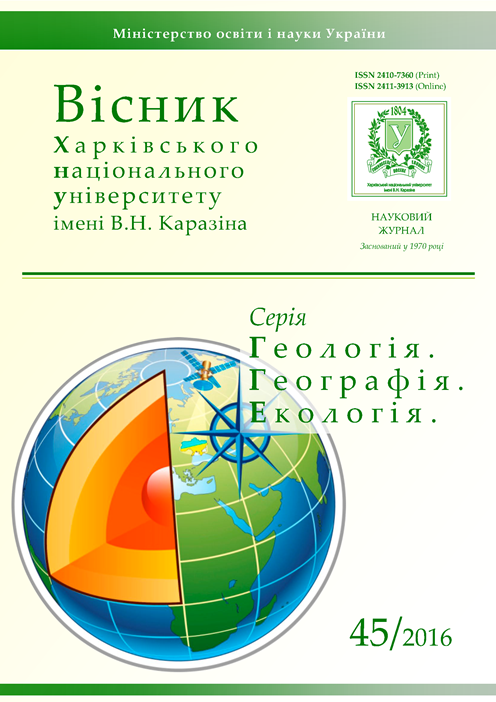On some peculiarities of carbonate rocks suffusion
Abstract
The features of carbonate rocks suffusion are considered in the article. On the example of Upper Cretaceous marl-chalk strata exposures in the southern part of Svyatogorsky brachyanticline the authors have showed that suffusion is the result of physical (mechanical) activity of infiltration water forming a solid surface and subsurface runoff. The most important component of suffusion is a solid flow module calculated on the basis of monitoring data. Its value depends on the climate, geology, manifestations of modern tectonics, lithology and hydrogeology of the research areas.
It has been revealed that suffusion processes in the marl-chalk stratum not only lead to denudation of carbonate rocks, but also increase the intensity of water exchange in them. The authors have experimentally proved that suffusion development is subject to the dynamics of infiltration waters in different seasons of the year, therefore the most intensive process takes place in spring and autumn.
During the field studies we have found out that the power of suffusion processes depends on the relief nature as one of the main natural factors regulating their direction. Geomorphological features of the territory determine the speed of filtration water flows, conditioning the intensity of mechanical destruction in the rocks in the weathering zone. This relief erosive energy depends on the erosion base depth and the shape of slopes.
Suffusion processes in the study area develop on the background of recent tectonic activity of Petrovsky-Kreminian fault connected not only with the disintegration of the carbonate rocks in the mountain range, but also with recent rise of the territory. Upward development of the relief is accompanied by an increase in the denudation processes capacity and, consequently, an increase in their influence on the earth's surface, rocks and soils. From the point of view of geomorphology, recent suffusion is manifested as morphologically young cup-like shapes, suffusion channels, ravines, gullies, suffusion landslides, etc.
At the stage of carbonate rocks suffusion development characterized by fragmentation of the particles to the colloidal size, we observe transition of purely physical (suffusion) processes into chemical (karst) ones in the system "rock - water", which meets one of the basic laws of nature on the transition of quantitative changes into qualitative ones.
Downloads
References
2. Babynets, A. E. (1961). Podzemnie vodi yuho-zapada Russkoy platform. Kyev, Izd-vo AN USSR, 378.
3. Veryhyn, N. N., Sherzhukov, B. S. (1969). Dyffuzyya y massoobmen pry fyl'tratsyy zhydkostey v porystikh sredakh. V kn.: Razvytye yssledovanyy po teoryy fyl'tratsyy v SSSR (1917-1967). M., Nauka, 237-313.
4. Shestopalov, V. M., Sytnykov, A. B., Lyal'ko, V. Y. i dr. (1988). Vodoobmen v hydroheolohycheskykh strukturakh Ukrayni. Metodi yzuchenyya vodoobmena. Izd. IHN AN USSR, Kyev, Nauk. dumka, 272.
5. Hydroheolohyya SSSR. T. VI, Donbass (1971). M., Nedra. 480.
6. Hirnychyy entsyklopedychnyy slovnyk, t. 2. (2002). Za red. V.S. Bilets'koho. Donets'k, Skhidnyy vydavnychyy dim, 632.
7. Demchyshyn, M. H., Anats'kyy, O. M. (2008). Inzhenerno-heolohichni umovy v dolynakh rivnynnykh rik. U zb. «Budivel'ni konstruktsiyi». K., NDIBK, Kn. 1, 71, 156-164.
8. Emel'yanova, E. H. (1972). Osnovnie zakonomernosty opolznevikh protsessov. M., Nedra, 310.
9. Kosmachev, V. H. (1975). Drevnyy karst v Yzyumskom rayone. Putevodytel' ekskursyy III s`ezda Heohrafycheskoho obshchestva USSR. Kh., Oblpolyhrafyzdat, 55-58.
10. Lomtadze, V. D. (1978). Ynzhenernaya heolohyya. Spetsyal'naya ynzhenernaya heolohyya. L., Nedra, 496.
11. Lopatyn, H. V. (1950). Erozyya y stok nanosov. Pryroda, 7, 19-28.
12. Luhovoy, V. P., Ostapenko, Yu. S., Zhuryn, S. M., Sukhov, V. V. (1999). Osobennosty razvytyya suffozyonnikh yavlenyy na terrytoryy s yntensyvnoy tekhnohennoy nahruzkoy. Visnyk KhNU imeni V. N. Karazina, seriya «Heolohiya – Heohrafiya – Ekolohiya», 455, 65-72.
13. Lushchyk A. V., Morozov V. Y., Myleshyn V. P. (1981). Podzemnie vodi karstovikh platformennikh oblastey yuha Ukrayni. K., Nauk. Dumka, 200.
14. Lushchyk A. V., Lysychenko H. V., Yakovlev E. O. (1988). Formyrovanye rezhyma podzemnikh vod v rayonakh razvytyya aktyvnikh heodynamycheskykh protsessov. K., Naukova dumka, 164.
15. Pynneker E. V., Pysarskyy B. Y., Shvartsev S. L. y dr. (1982). Osnovi hydroheolohyy. Heolohycheskaya deyatel'nost' y ystoryya vodi v zemnikh nedrakh. Novosybyrsk, Nauka, 239.
16. Pavlov, A. N. Heolohycheskyy kruhovorot vodi na Zemle(1974). M., Misl', 448.
17. Sukhov, V. V. (2009). Typyzatsyya slozhnikh ynzhenerno-heolohycheskykh uslovyy y ystochnykov heolohycheskoy opasnosty dlya pamyatnykov ystoryy y arkhytekturi. Visnyk KhNU imeni V. N. Karazina, seriya «Heolohiya – Heohrafiya – Ekolohiya», 864, 89-93.
18. Sukhov, V. V. (2012). Ynzhenerno-heolohycheskye y hydroheolohycheskye faktori vlyyanyya na stabyl'nost' ystoryko-arkhytekturnikh pamyatnykov. Visnyk KhNU imeni V. N. Karazina, seriya «Heolohiya – Heohrafiya – Ekolohiya», 997, 73-76.
19. Suyarko, V. H., Sukhov, V. V. (2015). Kontseptual'na synerhetychna heoloho-hidroheolohichna model' rozvytku sufoziyi ta karstu u karbonatnykh porodakh na terytoriyi Svyatohirs'koho monastyrya. Visnyk KhNU imeni V. N. Karazina, seriya «Heolohiya. Heohrafiya. Ekolohiya», 1157, 63-68.
20. Chaban M. O. (1981). Kryteryy natural'noho podobyya v hydroheolohyy. Vodnie resursi, 1, 64-76.
21. Shestopalov, V. M., Klymchuk, A. B., Tokarev, S. V., Amelychev, H. N. (2009). Otsenka uyazvymosty podzemnikh vod rayonov otkritoho karsta (na prymere massyva Ay-Petry, Krim). Speleolohyya y karstolohyya, 2, 11-29.
22. Enhel'hart, V. (1968). Porovie vodnie rastvori y katahenez porod. V kn. Dyahenez y katahenez osadochnikh obra-zovanyy. M., Myr, 443-458.





